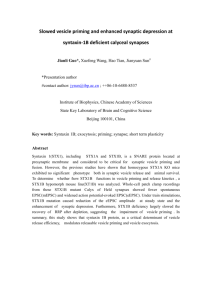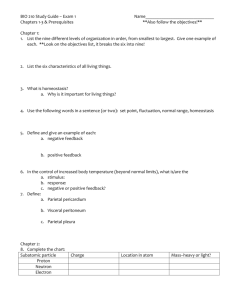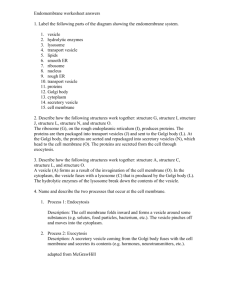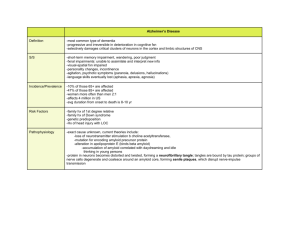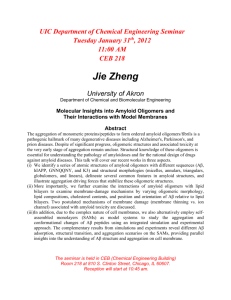An Amyloid Organelle: Solid State NMR Evidence for Please share
advertisement
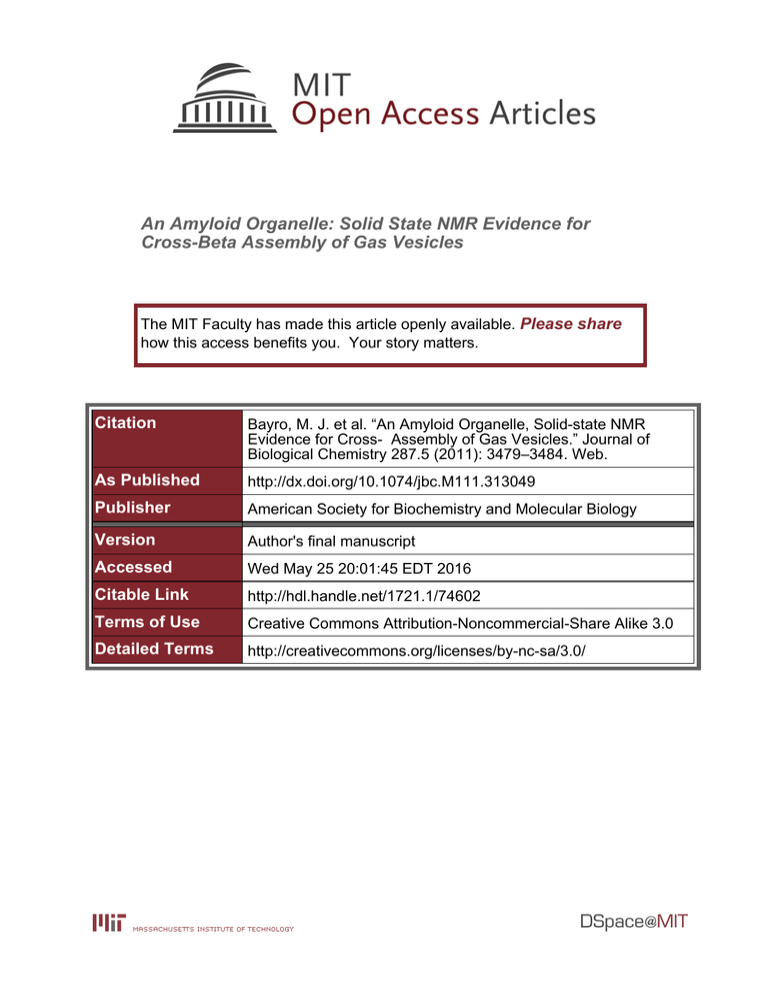
An Amyloid Organelle: Solid State NMR Evidence for
Cross-Beta Assembly of Gas Vesicles
The MIT Faculty has made this article openly available. Please share
how this access benefits you. Your story matters.
Citation
Bayro, M. J. et al. “An Amyloid Organelle, Solid-state NMR
Evidence for Cross- Assembly of Gas Vesicles.” Journal of
Biological Chemistry 287.5 (2011): 3479–3484. Web.
As Published
http://dx.doi.org/10.1074/jbc.M111.313049
Publisher
American Society for Biochemistry and Molecular Biology
Version
Author's final manuscript
Accessed
Wed May 25 20:01:45 EDT 2016
Citable Link
http://hdl.handle.net/1721.1/74602
Terms of Use
Creative Commons Attribution-Noncommercial-Share Alike 3.0
Detailed Terms
http://creativecommons.org/licenses/by-nc-sa/3.0/
An Amyloid Organelle: Solid State NMR Evidence for Cross-Beta Assembly of Gas Vesicles *
Marvin J. Bayro,‡,ǁ‖ Eugenio Daviso,ǁ‖,¶ Marina Belenky,¶ Robert G. Griffin,‡,ǁ‖ Judith Herzfeld¶,1
ǁ‖
From the ‡Department of Chemistry, Massachusetts Institute of Technology, Cambridge, MA 02139,
Francis Bitter Magnet Laboratory, Massachusetts Institute of Technology, Cambridge, MA 02139, and
¶
Department of Chemistry, Brandeis University, Waltham, MA 02454
*Running Title: An Amyloid Organelle
1
To whom correspondence should be addressed: Judith Herzfeld, Department of Chemistry, Brandeis
University, Waltham, MA 02454-9110, USA, Tel.: (781) 736-2538; Fax: (781) 736-2516; E-mail
herzfeld@brandeis.edu
Keywords: Amyloid, Cyanobacteria, Protein Self-Assembly, Protein-Protein Interactions, Solid-State
NMR Spectroscopy, Magic-Angle Spinning, Air-Water Interface
Background: The gas vesicles of aquatic
microorganisms are hollow proteinaceous shells
with remarkable physical properties that enable
them to function as floatation organelles.
Result: The gas vesicle subunits associate in a
cross-beta arrangement.
Conclusion: The gas vesicle wall constitutes a
functional amyloid.
Significance: This new category of functional
amyloid broadens our understanding of the diverse
roles of the amyloid fold.
Introduction
Found in a wide variety of organisms and
associated with pathological and functional states,
amyloids are open-ended protein assemblies
characterized by a highly ordered cross-β
architecture in which the β-strands are oriented
transverse to the polymerization axis (1-3).
Amyloid fibrils have been observed in a large
number
of
pathologies,
including
neurodegenerative
disorders
and
systemic
amyloidoses (1). However, the discovery of in
vitro fibril formation by proteins unrelated to
disease has led to the notion that amyloid is a
generic and accessible state in the protein folding
landscape (4). Moreover, proteins in organisms
ranging from bacteria to mammals have been
found to form amyloid structures that carry out
specific functions and are referred to as functional
amyloids (5). While functional amyloids share the
general morphology of disease-related amyloids,
they possess key distinctive features related to the
control of fibril formation. These include
sequestration of the proteins to avoid aberrant
fibril formation, rapid fibril elongation that avoids
the accumulation of intermediates, and regulation
of both assembly and disassembly (6). Thus the
discovery and study of functional amyloid systems
have provided new insights into the diverse ways
in which proteins adopt amyloid structures (7).
SUMMARY
Functional amyloids have been identified in a
wide range of organisms, taking on a variety of
biological roles, and being controlled by
remarkable mechanisms of directed assembly.
Here we report that amyloid fibrils constitute
the ribs of the buoyancy organelles of Anabaena
flos-aquae. The walls of these gas-filled vesicles
are known to comprise a single protein, GvpA,
arranged in a low-pitch helix. However, the
tertiary and quaternary structures have been
elusive. Using solid-state NMR correlation
spectroscopy we find detailed evidence for an
extended cross-β structure. This amyloid
assembly helps to account for the strength and
amphiphilic properties of the vesicle wall.
Buoyancy organelles thus dramatically extend
the scope of known functional amyloids.
1 Gas vesicles are buoyancy organelles that
enable aquatic microorganisms to regulate their
depth in the water column for optimal access to
light and nutrients (8). The gas vesicle wall
consists almost exclusively of a single protein, gas
vesicle protein A (GvpA)2, one of the most
hydrophobic proteins known, while other proteins
in the gas vesicle gene cluster either provide
additional strength by binding to the exterior
surface of the vesicle wall or appear to have roles
in the assembly process (8). Figure 1 shows a
schematic of the overall organization of gas
vesicles. Early electron microscopy revealed
ribbed spindles {Jost, 1970 #66} which, at higher
resolution proved to be bipolar with low pitch
helices forming the ribs {Offner, 1998 #14}. X-ray
diffraction studies determined the thickness of the
vesicle wall and the dimensions of the unit cell
within the wall {Blaurock, 1976 #52}. These were
found to be consistent with the size of the GvpA
monomer. In addition, the x-ray diffraction
showed reflections characteristic of β-sheets with
strands oriented at an angle of 36° relative to the
long axis of the vesicle. These last features have
recently been confirmed by atomic force
microscopy {McMaster, 1996 #13}.
Figure 1 also shows a recently proposed model
of the quaternary structure involving an
asymmetric dimer repeat unit (12). The model was
initially developed based on the secondary
structure propensity of the sequence, the positions
of conserved residues among different organisms,
electrostatic energy considerations, and the x-ray
determined tilt of the β-strands relative to the
vesicle axis (12). In this model, GvpA monomers
contain a β-hairpin that forms an antiparallel βsheet within the monomer. This β-sheet is
extended by anti-parallel association of the βsheets in adjacent monomers. A key to fulfilling
the above considerations is that the center of the βturn alternates between V34 and G35 in
neighboring monomers.
Previous
solid-state
nuclear
magnetic
resonance (NMR) studies have provided support
for the secondary structures inherent in the model:
the asymmetric dimer repeat unit is consistent with
duplicated resonances found in the initial study
(12) and further experiments revealed that the
protein backbone adopts a coil-alpha-beta-betaalpha-coil conformation, in close agreement with
the secondary structure tendency of the protein
sequence (13). Here we show that the β-strands of
GvpA form form the contacts predicted by the
model. It thus appears that the gas vesicle wall
comprises a helically wound amyloid fibril.
EXPERIMENTAL PROCEDURES
Preparation of gas vesicles – Cells of
Anabaena flos-aquae (strain 1403/13f, Cambridge
Collection of Algae and Protozoa, Cambridge,
UK) were grown in an atmosphere containing
13
CO2 and 15N2 to produce uniformly 13C and 15N
labeled cells. Floating cells were collected and
lysed to release gas vesicles which were isolated
and washed by repeated floatation as described
previously (12). Washed vesicles were collapsed
by a pressure pulse, pelleted by centrifugation, and
packed into 3.2 mm rotors, with approximately 24
mg of sample per rotor.
Solid-state NMR spectroscopy – MAS NMR
experiments were performed using a customdesigned spectrometer (D. J. Ruben, Francis Bitter
Magnet Laboratory, Cambridge, MA) operating at
700 MHz 1H Larmor frequency and equipped with
1
a
triple-resonance
H/13C/15N
VarianChemagnetics (Palo Alto, CA) probe fitted with a
3.2 mm MAS stator. Preliminary correlation
spectra were recorded using various schemes for
13
C-13C recoupling, including proton-assisted
recoupling (PAR) (14), proton-driven spin
diffusion (15), dipolar assisted rotational
resonance (DARR) (16,17), and band-selective
radio frequency-driven recoupling (18). PAR and
DARR spectra, recorded with 10 ms and 250 ms
mixing periods, respectively, presented optimal
sensitivity in these uniformly 13C-labeled samples
and were selected for further analysis. Twodimensional spectra were acquired with 256
indirect points, with a 60 ms dwell time and 320
transients per point. High-power, two-pulse phase
modulation 1H decoupling (19) was applied during
the evolution and detection periods.
Structural modeling – Representations of
GvpA assembly based on the asymmetric dimer
model were generated using CNS version 1.2 by
2 applying the simulated annealing protocol (20).
The structure was constrained by the backbone
torsion angles obtained from chemical shift
analysis, hydrogen bonds between putative βstrands, and translational symmetry between
dimers. Calculations were performed in three
stages, using an NOE potential. High temperature
annealing was carried out by performing
molecular dynamics at 50000 K for 15 ps in
torsion space starting from randomized
coordinates. The NOE and dihedral angle
restraints were applied with force constants of 150
kcal Å–2 and 100 kcal Å–2 respectively. This was
followed by fast cooling from 50000 K to 3000 K,
in steps of 250 K, with an evolution time of 15 ps
at each temperature. The final slow cooling, from
3000 K to 0 K, was carried out in steps of 25 K
with an evolution time of 15 ps at each
temperature. Typically, a set of 60 structures was
generated for each calculation, and the average of
these structures was calculated and minimized.
The results were visualized with VMD (21).
sequence because they provide strong evidence for
interstrand interfaces. For example, as shown in
Figure 1, the model has I23 opposite I47 across the
intramolecular interfaces of G-turn monomers and
opposite I45 across the intramolecular interfaces
of V-turn monomers. Similarly, the model has L39
opposite I47 across the intermolecular interface
between C-terminal segments and I23 opposite
L33 across the intermolecular interface between
N-terminal segments.
As shown in Figure 2, contacts corresponding
to interactions between the above residue pairs are
observed as cross-peaks in the 13C-13C correlation
spectra. Numerous other predicted correlations are
also observed, as summarized in Table 1 and
Figure 3. In particular, backbone–side-chain and
side-chain–side-chain contacts are observed
between many pairs of residues opposing one
another in the proposed β-strand interfaces.
These solid-state NMR correlations represent
the first residue-level characterization of the
supramolecular architecture of the gas vesicle
wall. Taken together, they assert topological
constraints that are probably impossible to satisfy
in self-consistent fashion outside the extended,
antiparallel β-sheet arrangement of our model.
Some observed correlations are difficult to explain
without turns in adjacent monomers that are
shifted by one residue. For example, I45 shows
correlations with both I25 and I23, while I23
shows correlations with both I47 and I45. Other
observed correlations, require interstrand contacts.
For example, the extended secondary structure
precludes intrastrand contacts between D26 and
R30 and between L39 and I47. Taken together, the
correlations strongly support the proposed model.
RESULTS
As shown in Figure 1, the proposed model
presents four different interfaces between strands,
two intramolecular and two intermolecular. The
intramolecular interfaces are between the N- and
C-terminal portions of the β-hairpin within each of
the two types of monomers. The intermolecular
interfaces are between the N(C)-terminal segment
of the hairpin of one monomer and the N(C)terminal segment of the hairpin of the adjacent
monomer. Having previously assigned 80% of the
GvpA resonances in uniformly 13C and 15N labeled
gas vesicles of Anabaena flos-aquae (13), we
sought to validate our model by checking for the
predicted interactions between β-strands in longrange correlation spectra. For this purpose,
multiple sets of 13C-13C dipolar correlation spectra
were recorded under different experimental
conditions. The hypothetical model guided our
analysis by focusing on potential interstrand
contacts within 6 Å, the approximate limit of the
dipolar interactions probed by our experiments. Of
particular significance are contacts between βstrand residues that are far apart in the primary
DISCUSSION
Core β-sheet structure of gas vesicles
The structural constraints described above
indicate that the intermolecular association
between GvpA subunits along the winding
filament that forms the ribs of the gas vesicle wall
is primarily mediated by β-sheet formation on
both sides of the β-hairpin. Thus the β-strands in
the middle of the amino acid sequence form the
core of the GvpA assembly in the direction of the
3 rib, approximately perpendicular to the long
vesicle axis. This is at variance with a recently
reported model involving docking of prefolded
monomers (23). However, that work made use of a
single monomer fold, rather than two folds
differing in the location of the β-turn.
Furthermore, that fold was optimized in bulk
solvent, rather than at an air-water interface, and it
was not allowed to adapt to interactions with
neighbors during docking. The result was a twodimensional array with holes within and between
ribs that make it resemble a sieve more than a
barrier. It is difficult to reconcile such a structure
with the physical properties of the gas vesicle
wall.
The question remains what roles are played by
the GvpA sequences that flank the β-strands. In
our model, these segments are attached to the
edges of the amyloid ribbons at locations
corresponding to the interfaces between the gas
vesicle ribs (see Figure 4). Such an arrangement is
consistent with the transverse ridges that are
observed in electron micrographs and atomic-force
micrographs of gas vesicles (10). Mass
spectrometry shows that the helices and coils of
gas vesicle are largely protected from proteolysis
(24), and solid-state NMR spectra indicate that
they are largely rigid (13). We therefore expect the
helices and coils to be constrained by yet-to-be
determined interactions with other parts of the
assembly, allowing them to hold the ribs together.
The major physical characteristics of the gas
vesicle wall, including its architecture, structural
strength and interfacial stability, reflect the general
features of the core β-sheet structure within the
ribs. The inter-rib spacing is determined by the
length of the β-strand segments and their
inclination from the vesicle axis (see Figure 1).
The strand orientation also sets the hydrogen
bonds at an angle that provides equal strength
along and transverse to the cylinder axis (8). In
addition, the sequences in the β-strands are such
that one surface of the β-sheet is highly
hydrophobic and likely responsible for precluding
water condensation inside the vesicles. Therefore,
the cross-β core structure of the gas vesicle rib
allows for formation of a resilient supramolecular
assembly that can stabilize an air-water interface.
Some of the above structural features resemble
morphological properties generally found in
amyloid fibrils. The cross-β assembly along the rib
of the gas vesicle wall is similar to the ribbon-like
structure formed by amyloid fibrils, which often
presents a twist that arises from the inherent lefthanded twist of β-sheets formed by L-amino acids
(25). Instead of a twist, the ribs of gas vesicles curl
around the long vesicle axis to produce the
cylindrical shape of the wall. While the twist of
amyloid fibrils thus appears to be an incidental
feature of generic extended β-sheet structures, the
curl of gas vesicle ribs serves a specific purpose in
the formation and elongation of this organelle.
Furthermore, just as the pitch of the twist varies
among amyloid fibrils, gas vesicles from different
organisms are found with different diameters that
depend on the sequence of the GvpA (8). Finally,
amyloid fibrils often consist of multiple, laterally
arranged protofilaments, held together by lateral
interactions at the edges of the cross-β core. In the
same way, amyloid in adjacent ribs of the gas
vesicle wall must interact laterally to secure the
overall assembly.
The gas vesicle ribs differ from other amyloid
fibrils in two notable respects. First, the β-strands
of gas vesicles cross the fibril at 54° to the fibril
axis, rather than at a canonical ~90°. As noted
elsewhere, this tilt contributes to the mechanical
strength of the gas vesicles (8), a feature that is
presumably irrelevant for pathological amyloids
and relatively unimportant for the other functional
amyloids. Second, the β–strands in gas vesicles
are arranged anti-parallel fashion, rather than the
more common parallel (usually, but not always,
in-register) configuration {Shewmaker, 2011
#65}. This is another feature that is expected to
contribute to the strength of the vesicle wall
because the straight hydrogen bonds of antiparallel β-sheets are stronger than the bent
hydrogen bonds of parallel β-sheets.
Amyloid formation and the air-water interface
Hydrophobic-hydrophilic interfaces, have
been found to enhance the self-assembly of a
variety of amyloid-forming peptides into β-sheets,
4 both parallel and antiparallel. For example,
Amyloid-β peptide, associated with Alzheimer’s
disease, has an amphipathic character and forms βsheets at air-water interfaces (26). Similarly,
recent studies have revealed the critical role of
hydrophobic-water interfaces in driving fibril
formation by islet amyloid polypeptide and αSynuclein, peptides associated with type 2
diabetes and Parkinson’s disease, respectively
(27,28). In gas vesicles, it is to be expected that
the air-water interface developed by the
hydrophobic interior of the gas vesicle wall has the
reciprocal effect of stabilizing the amyloid
structure of the ribs and facilitating the
incorporation of GvpA subunits during vesicle
growth.
Current models of hydrophobin assembly
(29,30) are based on compact subunits oriented by
a hydrophobic patch into the air-water interface,
where they join together to form intermolecular βbarrels. Whereas these secreted amphipathic
proteins respond to air-exposed environments, the
air-water interface in gas vesicles is itself
developed by the gas vesicle wall. For this more
rigorous purpose, the continuous hydrophobic
surface of β-sheets that are co-planar with the airwater interface seems better suited than discrete
hydrophobic patches on the surface of β-barrel
units and resembles more closely the β-sheets
formed by disease-related amyloidogenic peptides
at hydrophobic-hydrophilic interfaces.
by the aggregation properties of the sequence
(31,32). On the other hand, several current models
of the assembly of functional amyloids appear to
be consistent with preservation of the secondary
structure tendencies of the amino acid sequence.
For example, supramolecular models of CsgA, the
main constituent of curli fibers, are based on
repeating segments with sequences predicted to
adopt β-strand conformations (33). In the amyloid
assembly of hydrophobins, which are soluble and
some of which have known monomeric structures,
the antiparallel β-sheets present in the monomeric
fold are likely to be preserved after polymerization
and flexible loops at each end of the cylindrical
monomer appear to establish intermolecular
interactions. One of these two loops, disordered in
monomer form, is predicted to adopt a β-sheet
conformation according to sequence analysis and
evidently induces a β-sheet conformation in its
partner (30). Therefore the correspondence
between sequence tendency and secondary
structure in the amyloid form found in GvpA may
be a general feature of functional amyloids,
reflecting the evolution of these systems to reach
and maintain their assembled state.
Gas vesicles are only soluble in highly protic
solvents and the monomers form amorphous
precipitates when such solvents are dialyzed away.
It is not fully understood how misfolding of GvpA
is avoided in the cell, but since the expression of
multiple gas vesicle genes is required for gas
vesicle formation, other proteins in this gene
cluster may transport GvpA and assist its insertion
into the growing vesicle. Mechanisms to prevent
aggregation have been recognized in other
functional amyloids. The Ma component of
Pmel17 self-assembles very rapidly, at rates that
are several orders of magnitude faster than those
of disease-related peptides (34). It has been
suggested that these kinetics prevent the
accumulation of intermediates that may lead to
unwanted structures (5,34). Hydrophobin SC3
contains several highly conserved disulfide
bridges that are responsible for its solubility when
fully immersed in the aqueous environment, such
that self-assembly only occurs when triggered by a
hydrophobic interface (35). CsgA proteins require
Function and secondary structure tendencies
The functional fold of GvpA in the gas vesicle
wall contains structural elements consistent with
the secondary structure propensity of the amino
acid sequence. The high level of sequence
conservation in these structural elements (12) is
indicative of a highly evolved protein sequence
selected for structural integrity in the context of a
functional intermolecular assembly. This is in
contrast to natively globular proteins that form
amyloid fibrils under denaturing conditions. In
such cases, the secondary structure of the amyloid
state tends to deviate from the secondary structure
propensity of the amino acid sequence and instead
agrees more closely with the elements predicted
5 the expression of additional genes for export,
anchoring, and in vivo curli formation, but not for
self-assembly once outside the cell. In this system,
at least two other proteins function as chaperones
to prevent unwanted aggregation of CsgA (6). The
assembly of GvpA into gas vesicles seems to be
controlled in a fashion similar to that of CsgA
assembly into curli, with the further requirement
of the de novo formation of an air-water interface.
REFERENCES
1.
Chiti, F., and Dobson, C. M. (2006) Annu. Rev. Biochem. 75, 333-366
2.
Eanes, E. D., and Glenner, G. G. (1968) J. Histochem. Cytochem. 16, 673-677
3.
Sunde, M., Serpell, L. C., Bartlam, M., Fraser, P. E., Pepys, M. B., and Blake, C. C. F. (1997) J.
Mol. Biol. 273, 729-739
4.
Dobson, C. M. (1999) Trends Biochem. Sci. 24, 329-332
5.
Fowler, D. M., Koulov, A. V., Balch, W. E., and Kelly, J. W. (2007) Trends Biochem. Sci. 32,
217-224
6.
Smith, A. M., and Scheibel, T. (2010) Macromol. Chem. Physic. 211, 127-135
7.
Otzen, D., and Nielsen, P. (2008) Cell. Mol. Life Sci. 65, 910-927
8.
Walsby, A. E. (1994) Microbiol. Rev. 58, 94-144
9.
Blaurock, A. E., and Walsby, A. E. (1976) J. Mol. Biol. 105, 183-199
10.
McMaster, T. J., Miles, M. J., and Walsby, A. E. (1996) Biophys. J. 70, 2432-2436
11.
Offner, S., Ziese, U., Wanner, G., Typke, D., and Pfeifer, F. (1998) Microbiology 144, 1331-1342
12.
Sivertsen, A. C., Bayro, M. J., Belenky, M., Griffin, R. G., and Herzfeld, J. (2009) J. Mol. Biol.
387, 1032-1039
13.
Sivertsen, A. C., Bayro, M. J., Belenky, M., Griffin, R. G., and Herzfeld, J. (2010) Biophys. J. 99,
1932-1939
14.
De Paëpe, G., Lewandowski, J. R., Loquet, A., Böckmann, A., and Griffin, R. G. (2008) J. Chem.
Phys. 129, 245101
15.
Szeverenyi, N. M., Sullivan, M. J., and Maciel, G. E. (1982) J. Magn. Reson. 47, 462-475
16.
Takegoshi, K., Nakamura, S., and Terao, T. (2001) Chem. Phys. Lett. 344, 631-637
17.
Morcombe, C. R., Gaponenko, V., Byrd, R. A., and Zilm, K. W. (2004) J. Am. Chem. Soc. 126,
7196-7197
18.
Bayro, M. J., Maly, T., Birkett, N. R., Dobson, C. M., and Griffin, R. G. (2009) Angew. Chem.
Int. Ed. 48, 5708-5710
19.
Bennett, A. E., Rienstra, C. M., Auger, M., Lakshmi, K. V., and Griffin, R. G. (1995) J. Chem.
Phys. 103, 6951-6958
20.
Brunger, A. T., Adams, P. D., Clore, G. M., DeLano, W. L., Gros, P., Grosse-Kunstleve, R. W.,
Jiang, J.-S., Kuszewski, J., Nilges, M., Pannu, N. S., Read, R. J., Rice, L. M., Simonson, T., and
Warren, G. L. (1998) Acta Cryst. D 54, 905-921
21.
Humphrey, W., Dalke, A., and Schulten, K. (1996) J. Molec. Graphics 14, 33-38
22.
Khurana, R., Uversky, V. N., Nielsen, L., and Fink, A. L. (2001) J. Biol. Chem. 276, 2271522721
23.
Strunk, T., Hamacher, K., Hoffgaard, F., Engelhardt, H., Zillig, M. D., Faist, K., Wenzel, W., and
Pfeifer, F. (2011) Mol. Microbiol. 81, 56-68
24.
Belenky, M., Meyers, R., and Herzfeld, J. (2004) Biophys. J. 86, 499-505
25.
Fändrich, M. (2007) Cell. Mol. Life Sci. 64, 2066-2078
26.
Schladitz, C., Vieira, E. P., Hermel, H., and Möhwald, H. (1999) Biophys. J. 77, 3305-3310
27.
Jean, L., Lee, C. F., Lee, C., Shaw, M., and Vaux, D. J. (2010) FASEB J. 24, 309-317
6 28.
29.
30.
31.
32.
33.
34.
35.
Pronchik, J., He, X., Giurleo, J. T., and Talaga, D. S. (2010) J. Am. Chem. Soc. 132, 9797-9803
Hakanpää, J., Paananen, A., Askolin, S., Nakari-Setälä, T., Parkkinen, T., Penttilä, M., Linder, M.
B., and Rouvinen, J. (2004) J. Biol. Chem. 279, 534-539
Kwan, A. H. Y., Winefield, R. D., Sunde, M., Matthews, J. M., Haverkamp, R. G., Templeton,
M. D., and Mackay, J. P. (2006) Proc. Natl. Acad. Sci. USA 103, 3621-3626
Tartaglia, G. G., Pawar, A. P., Campioni, S., Dobson, C. M., Chiti, F., and Vendruscolo, M.
(2008) J. Mol. Biol. 380, 425-436
Bayro, M. J., Maly, T., Birkett, N. R., MacPhee, C. E., Dobson, C. M., and Griffin, R. G. (2010)
Biochemistry 49, 7474-7484
Hammer, N. D., Schmidt, J. C., and Chapman, M. R. (2007) Proc. Natl. Acad. Sci. USA 104,
12494-12499
Fowler, D. M., Koulov, A. V., Alory-Jost, C., Marks, M. S., Balch, W. E., and Kelly, J. W.
(2006) PLoS Biol. 4, e6
de Vocht, M. L., Reviakine, I., Wösten, H. A. B., Brisson, A., Wessels, J. G. H., and Robillard,
G. T. (2000) J. Biol. Chem. 275, 28428-28432
Acknowledgements – We thank Astrid Sivertsen, Kendra Frederick, Galia Debelouchina, and Vladimir
Michaelis for insightful discussions, and Ajay Thakkar and David Ruben for technical assistance.
Footnotes
*This work was supported by NIH grants EB001035, EB003151, and EB002026.
1
To whom correspondence should be addressed: Judith Herzfeld, Department of Chemistry, Brandeis
University, Waltham, MA 02454-9110, USA, Tel.: (781) 736-2538; Fax: (781) 736-2516; E-mail
herzfeld@brandeis.edu
2
The abbreviations used are: GVpA, Gas vesicle protein A; MAS, magic-angle spinning; CsgA, curli
subunit protein A; PAR, proton-assisted recoupling; DARR, dipolar-assisted rotational resonance.
FIGURE LEGENDS
FIGURE 1. Gas vesicle architecture and GvpA folding hypothesis. The gas vesicle is a ribbed cylinder
with conical end caps. The ribs of the vesicle comprise GvpA monomers assembled in a low pitch helix.
The horizontal lines shown within one of these ribs illustrate the orientation of the β-strands of GvpA as
determined by x-ray diffraction.(8) The expanded view of this rib shows the asymmetric dimer model of
the β-strands proposed by Sivertsen et al.(12) This model includes β-hairpins at G35 and V34 in
alternating monomers, resulting in four different interfaces within the β-sheet. From top-to bottom, these
are: GC-GN between the C- and N-terminal portions of the β-hairpin of a G-turn monomer; GN-VN
between the N-terminal portions of the β-hairpins of the G-turn monomer and the adjacent V-turn
monomer; VN-VC between the N- and C-terminal portions of the β-hairpin of the V-turn monomer; and
VC-GC between the C-terminal portions of the β-hairpins of the V-turn monomer and the succeeding Gturn monomer.
FIGURE 2. Examples of NMR correlations between β-strand residues that are distant in the primary
sequence. Details of the annealed asymmetric dimer model are shown on the left and examples of
corresponding correlations are shown on the right. From top to bottom: The GC–GN interface represented
by I47 and I23 in a single G-turn subunit; the GN–VN interface represented by I23 in a G-turn subunit and
L33 in a V-turn subunit; the VN–VC interface represented by I23 and I45 in a single V-turn subunit; and
7 the VC–GC interface represented by L39 in a V-turn subunit and I47 in the neighboring G-turn subunit.
The green, blue, and red colors on the left denote polar, basic, and acidic residues, respectively. Each
spectrum on the right is a portion of either the 10 ms PAR spectrum (third from the top) or the 250 ms
DARR spectrum (the other three). The full spectra are shown in the online Supporting Data.
FIGURE 3. Interstrand correlations between residues across the four different interfaces of the β-sheet
assembly. The four interface labels are as defined in the legend to Figure 1. The numeral in the circle
between two residues indicates the number of observed 13C-13C correlations assigned in each case (see
Table 1).
FIGURE 4. Model of the amyloid ribbon segment formed by three GvpA molecules, illustrating
possibilities for rib-rib interactions. The α-helical and coil portions of GvpA are included without any
tertiary constraints. Located at the edges of the amyloid ribbon, they are well situated to be involved in
rib-rib interactions that are likely to also include the turn portions of the β-strands.
8 TABLE 1. Correlations observed in 13C-13C spectra that correspond to inter-residue interactions along the
four β-strand interfaces in our model of gas vesicle organization. These correlations are based on resolved
cross-peaks assigned according to chemical shifts published previously (13), except for those in the
segment V29-L33, which were identified subsequently. (*) Identifies correlations found in the DARR
spectrum using a mixing time of 250 ms. (^) Identifies correlations found in the PAR experiment using a
mixing time of 10 ms.
GC-GN
GN-VN
VN-VC
VC-GC
I47CG2-I23CB*^
I47CD1-I23CB*^
V46CB-V24CG1*^
I45CB-I25CG2*^
I45CD1-I25CG2*
R44CB-D26CB*
E42CB-W28CB*
I41CG1-V29CG1*^
I41CD1-V29CG1*^
I41CD1-V29CG2*
A40CB-R30CD*^
L38CG-S32CA*^
E37CA-L33CB*
E37CB-L33CB*^
E37CB-L33CG*^
I23CD1-L33CA*
I23CG2-L33CA*
V24CG1-S32CA*^
I25CG1-V31CG2*^
I25CG2-V31CB*^
D26CB-R30CG*^
D26CB-R30CD*^
S32CA-I36CD1*^
S32CB-I36CB*
V31CG2-E37CB*^
V29CG1-L39CG2*^
A27CB-I41CD1*^
D26CB-E42CA*
D26CB-E42CB*
I25CG2-A43CB*^
V24CG1-R44CD*
V24CG2-R44CD*
I23CG2-I45CA*
I23CD1-I45CA*^
E37CB-S49CB*^
L38CB-A48CA*^
L38CB-A48CB*^
L38CG-A48CA*^
L39CA-I47CA*
L39CA-I47CB*
L39CD1-I47CG2*^
L39CD2-I47CB*^
L39CD2-I47CG2*^
A40CA-V46CA*^
A40CB-V46CB*^
I41CA-I45CD1*^
E42CA-R44CA*^
E42CB-R44CA*^
9 FIGURE 1
10 FIGURE 2
11 FIGURE 3
12 FIGURE 4
13


